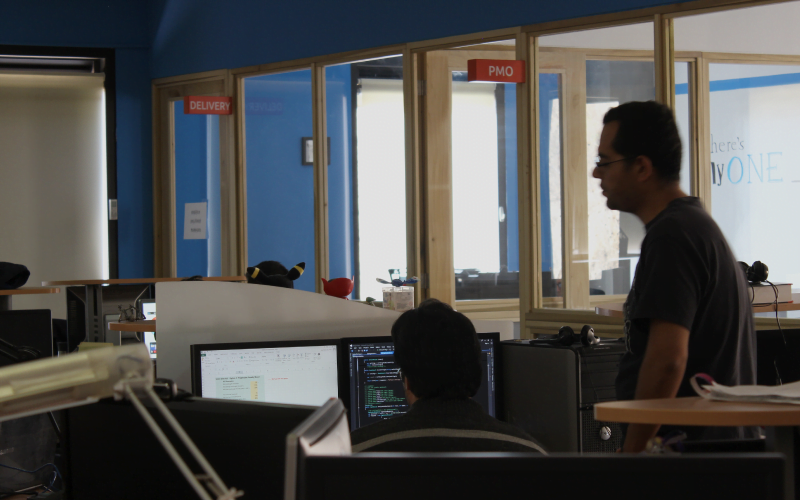Curated by: Sergio A. Martínez
When it comes to the Technology sector in most countries, one fact has been making itself clear since the beginning of the COVID-19 pandemic in 2020: talent shortage is on the rise. In fact, according to a survey by the Harvey Nash Group, among 3000 tech leaders, 67% acknowledged a lack of availability of skilled software developers, and this gap will only increase as our demand for technological solutions (like platforms, applications, and programs) keeps growing as in the past couple years.

“The global events of the past two years have seen the appetite for emerging and innovative technologies, such as cloud computing, big data, and artificial intelligence, increase dramatically across all industries”, indicates an article by the Australian Financial Review. “But the current pipeline of talent simply cannot keep up with the pace at which jobs are being vacated or created.”
The projections about this talent gap are not very optimistic, at least when it comes to the local US developer pool. According to the blog Youteam.io, the US alone will face a shortage of 85.2 million competent tech workers by 2030, which means the loss of revenue opportunities totaling $8.452 trillion in less than a decade.
So to solve this problem, many companies have been turning to a myriad of solutions to try and mitigate this gap, like adopting “IA-generated software” or “no-code” platforms to ease development without depending too much on skilled talent, but the long-term success and viability of this strategy is still unknown, especially among smaller-sized organizations.
A different challenge for every organization
It’s also important to note that this talent gap is not the same across the software industry, and different organizations of different sizes face very different challenges when it comes to attracting and retaining skilled developers. The main one is that corporations like Google or Amazon drain the local talent pools, adding about 45,000 new tech jobs for the roughly 2000 new developers entering the workforce in 2022 alone, according to a report by the tech blog 8allocate.
What this means is that small and medium-sized companies, even with the advantages they offer in terms of culture and perks, have a more difficult time attracting talent to remain competitive, which only exacerbates the issue. However, the silver lining is that, as the software development industry becomes increasingly globalized, many companies are outsourcing their software development needs to countries with lower labor costs to remain competitive, one of many reasons the practice of outsourcing software development has become so popular in the US.
For one thing, it can be a great way to save money; development studios in countries like India and China often charge significantly less for their services than US-based companies, in addition to helping businesses tap into a global pool of talent. In many cases, it’s simply more efficient and cost-effective to collaborate with developers in other countries than it is to try to find and hire talented software developers locally, especially during a labor shortage like the one we are currently seeing.
“Outsourcing software development always had its place as a go-to solution for speeding up development, but with everyone working remotely, the playing field has been leveled. Incorporating outside development teams is now just as viable of an option.” However, the potential downsides to outsourcing software development to these countries, such as language barriers and cultural differences, are well known. So while this may bring a solution in the short term, it can also lead to problems in the long run. For example, when software developers are based in different time zones, it can be difficult to coordinate efforts and collaborate effectively, in many cases thanks to the cultural differences that are present between both territories, a challenge that Nearshore development easily solves.
Nearshore development: Talent in the same time zone

As the software development industry continues to face this talent shortage and the skill gaps they produce, tech companies will need to find ways to remain competitive. One possibility is a focus on Nearshore software development, which provides several advantages over traditional offshore outsourcing, including improved collaboration and a closer cultural fit, thanks to being located in time zones that are more favorable for communication. In the case of the US, for example, there exists the advantage of working with the talent available in Mexico and the rest of LATAM. According to Stack Overflow:
“Mexico is home to 223 thousand software developers, and with the constant rise in the count of IT specialists, the country provides access to a huge array of developers. It also holds expertise in Agile development, Blockchain, the Internet of Things, and Analytics. Among the many reasons to opt for Mexico to outsource your software is the perfectly aligned time-zone between the United States and Mexico due to the border it shares and the high number of English-speaking population, which makes the location even more ideal.”
As a result, Nearshoring can provide a more efficient and effective software development solution for US-based organizations, providing the same cost savings as outsourcing, reducing the risk of communication problems and other potential issues, without sacrificing anything in the way of skills or expertise, as Mexico and LATAM have a high technical base of talented developers, comparable (and even surpassing) those of Ukraine, China and India, with the added advantage of keeping close in the same time zone, and with similar culture and values.
So outsourcing software development to a Nearshore company like Scio, which has been a partner to over 200 US-based companies and projects since 2003, can be a great way to get the skills and expertise you need without having to hire full-time employees, offering a way to any organization keep competitive, even with a local shortage of technical talent.
So while the talent shortage might seem like a challenge going forward, especially in the increasingly tech-focused world of today, this gap can be sidestepped more easily than you imagine; within the same hours as your main offices, and with seamless communication across every team you partner with, Nearshore development has all the talent you need to keep marching onwards today.
The Key Takeaways

- Since the pandemic began, our need for technological and software solutions skyrocketed.
- This, in turn, leads to a huge demand for skilled software and technology developers, creating a shortage of them that will only grow.
- Not only this could seriously impact the industry in the future, to the tune of billions of dollars lost, but has also created certain inequality among software development organizations.
- Big corporations drain the local talent pools, and solutions like IA and no-code platforms are imperfect for the current demands of the market.
- However, the wealth of technological and development skills in Mexico and the rest of LATAM present a solution for this in the shape of Nearshore collaboration, which has similar cultural values, and within the same time zones.
- Nearshore development offers the best talent available in these geographical locations, without some of the obstacles present in offshore development, becoming a win-win for both sides of the industry.
Scio is an established Nearshore software development company based in Mexico that specializes in providing high-quality, cost-effective technologies to help you reach new heights. We have been developing since 2003 and our experience gives us access not only to the knowledge but also the expertise needed when tackling any project. Get started today by contacting us about your project needs – we’ll be happy to help you achieve your business goals.
